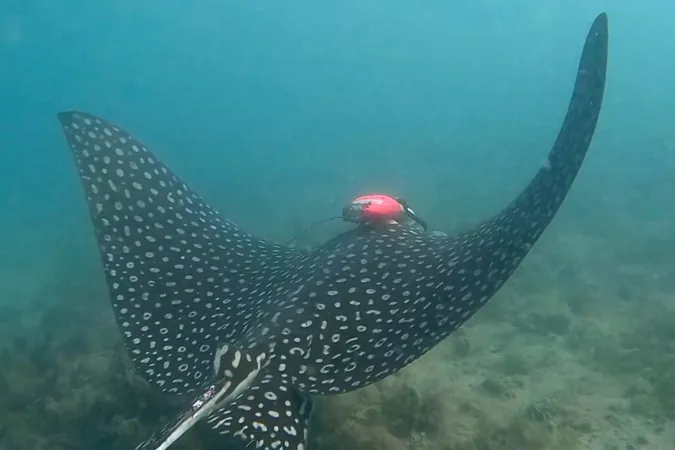
Bermuda Breakthrough: Scientists Track Elusive Whitespotted Eagle Rays for the First Time!
2025-07-24
Author: Jia
A Historic Marine Science Milestone
In an exciting breakthrough for marine biology, researchers have successfully tracked the elusive whitespotted eagle ray—a majestic predator of the ocean. Utilizing cutting-edge biologging technology, scientists from Florida Atlantic University have attached innovative multi-sensor tags to these mysterious creatures in Harrington Sound, Bermuda.
Unlocking the Secrets of a Marine Marvel
The findings, recently published in the journal *Animal Biotelemetry*, shed light on the feeding, movement, and social behaviors of the whitespotted eagle ray (Aetobatus narinari). These powerful, fast-swimming predators glide through tropical waters, often growing over 2 meters (6.5 feet) wide and weighing several hundred kilograms. Their diet consists primarily of hard-shelled prey, including clams and conch, making them vital players in marine ecosystems.
The Challenge of Tracking Rays
Historically, tracking these graceful creatures has been a challenge. With their smooth skin and absence of a prominent dorsal fin, attaching tracking devices has proven difficult. Unlike their more widely studied counterparts like sharks and sea turtles, rays have largely been overlooked, raising concerns as many species face threats from habitat loss and overfishing.
Revolutionary Tracking Technology
The biologging tags developed for this study are marvels of innovation. They combine a motion sensor, underwater microphone, video camera, satellite transmitter, and acoustic tracker into a lightweight design that adheres securely using silicone suction cups and specialized straps.
Remarkably, these tags can remain attached for up to 60 hours, even in turbulent waters—setting a new record for external tags on pelagic rays, a significant leap in marine tagging technology.
Groundbreaking Discoveries
Data collected from the tags has revealed insights into the rays' movement, feeding strategies, and environmental navigation. Researchers captured video and audio recordings to identify essential behaviors like 'browsing,' 'swimming,' and 'digging.' Using a machine learning model, they successfully analyzed the foraging techniques of these rays, recognizing feeding events through movement and sound alone.
A New Era in Marine Research
Co-author Cecilia M. Hampton highlighted the significance of these findings, stating, "We've demonstrated that complex behaviors can be identified using sound and movement data alone, which could pave the way for simpler, more efficient tagging methods in the future. These new techniques could revolutionize our understanding of elusive marine species like pelagic rays, turning them into mobile surveyors of ocean health."
The Future of Marine Conservation
Looking ahead, the researchers believe that the success of this study exemplifies how biologging technology, coupled with machine learning, can transform the observation of marine life. By refining this tagging method, scientists can fill crucial knowledge gaps about marine ecosystems, making significant strides in conservation efforts.
The journey into the depths of our oceans has just begun, and with advanced technology at their fingertips, researchers are poised to unlock even more secrets of the seas!




 Brasil (PT)
Brasil (PT)
 Canada (EN)
Canada (EN)
 Chile (ES)
Chile (ES)
 Česko (CS)
Česko (CS)
 대한민국 (KO)
대한민국 (KO)
 España (ES)
España (ES)
 France (FR)
France (FR)
 Hong Kong (EN)
Hong Kong (EN)
 Italia (IT)
Italia (IT)
 日本 (JA)
日本 (JA)
 Magyarország (HU)
Magyarország (HU)
 Norge (NO)
Norge (NO)
 Polska (PL)
Polska (PL)
 Schweiz (DE)
Schweiz (DE)
 Singapore (EN)
Singapore (EN)
 Sverige (SV)
Sverige (SV)
 Suomi (FI)
Suomi (FI)
 Türkiye (TR)
Türkiye (TR)
 الإمارات العربية المتحدة (AR)
الإمارات العربية المتحدة (AR)